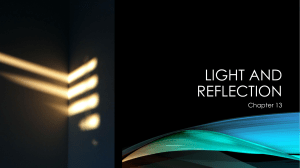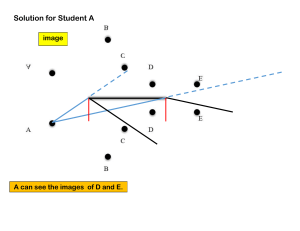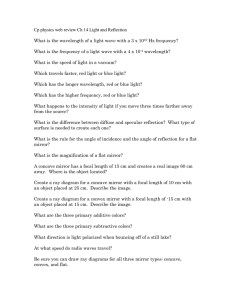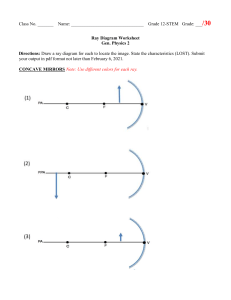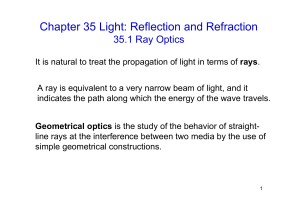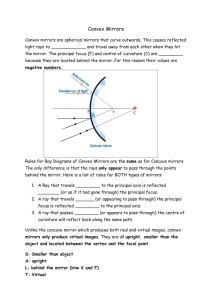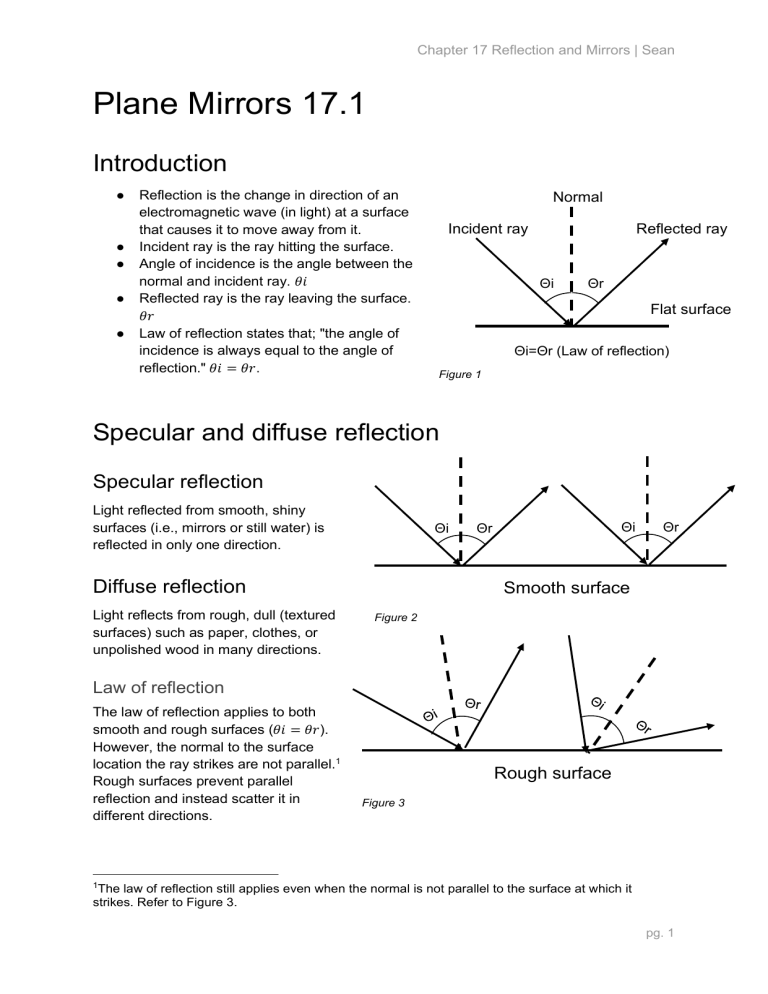
Chapter 17 Reflection and Mirrors | Sean Plane Mirrors 17.1 Introduction ● ● ● ● ● Reflection is the change in direction of an electromagnetic wave (in light) at a surface that causes it to move away from it. Incident ray is the ray hitting the surface. Angle of incidence is the angle between the normal and incident ray. 𝜃𝑖 Reflected ray is the ray leaving the surface. 𝜃𝑟 Law of reflection states that; "the angle of incidence is always equal to the angle of reflection." 𝜃𝑖 = 𝜃𝑟. Normal Incident ray Reflected ray Θi Θr Flat surface Θi=Θr (Law of reflection) Figure 1 Specular and diffuse reflection Specular reflection Light reflected from smooth, shiny surfaces (i.e., mirrors or still water) is reflected in only one direction. Θi Diffuse reflection Light reflects from rough, dull (textured surfaces) such as paper, clothes, or unpolished wood in many directions. Θi Θr Θr Smooth surface Figure 2 Different normal Law of reflection The law of reflection applies to both smooth and rough surfaces (𝜃𝑖 = 𝜃𝑟). However, the normal to the surface location the ray strikes are not parallel.1 Rough surfaces prevent parallel reflection and instead scatter it in different directions. Rough surface Figure 3 1 The law of reflection still applies even when the normal is not parallel to the surface at which it strikes. Refer to Figure 3. pg. 1 Chapter 17 Reflection and Mirrors | Sean Objects and plane mirror images Keywords ● ● ● Plane mirror is a flat, smooth surface from which light is reflected by specular reflection. Object is either a luminous source of light rays or is illuminated via a source of light. Virtual image is an image formed by diverging light rays. ○ Image is always on the opposite side of the mirror. ○ It is called a virtual image because there are no light rays present at the image location. Virtual image properties 1. Image appears to be the same distance behind the mirror. 𝑋𝑜 = 𝑋𝑖. 2. Image appears to be the same shape and size. 𝐻𝑜 = 𝐻𝑖. 3. Image is vertically oriented as the object is upside right. (As opposed to upside down.) 4. Image form is laterally inverted. (Left is right, right is left.) Steps to draw the image formed 1. Choose a point on the object, then draw a ray from the point to the mirror in different directions. 2. Reflect the rays off the mirror. 𝜃𝑖 = 𝜃𝑟. 3. Trace the reflected rays back into the mirror and find intersections. 4. Repeat for other points.23 2 These steps differ depending on the type of mirror and can be considered as rough instruction and inexact. 3 If he asks for steps in a test, note these down. ~ Sean pg. 2 Chapter 17 Reflection and Mirrors | Sean Curved and convex mirrors 17.2 Introduction ● ● Principal axis is the straight line (that includes the line segment). Perpendicular to the mirror’s surface dividing it in two halves. Focal point is a point at which incident light rays parallel to the principal axis converge after reflecting from a mirror. Convex mirror Concave mirror C F M M F C Figure 4 ● ● The distance between F and M is half the distance between CM. 𝑟 = 2𝑓. Focal length is the distance between the mirror and the focal point and can be 𝑟 expressed as 𝑓 = 2. ● Radius of curvature (r) is twice the length of the focal length. Concave mirrors Concave mirrors have inwardly curving reflection surfaces. ● Edges curve towards the observer. ● Reflected rays intersect the principal axis at point (f) and can be focused. ● The focal length is positive. Convex mirrors Convex mirrors have outwardly curving reflection surfaces with the edges that curve away from the observer. ● The focal length is negative. pg. 3 Chapter 17 Reflection and Mirrors | Sean Other keywords ● ● Real image is the image formed by converging light rays that invert the image. The image can be projected. Magnification (m) is the image’s height divided by the object’s height, equal to the negative image position divided by the object’s position. ℎ𝑖 𝑥𝑖 ○ 𝑚 = ℎ𝑜 = − 𝑥𝑜 ○ ℎ𝑖 = − ○ If |m| >1 the image is enlarged, |m|<1 the image is belittled, diminished. ■ The sign of magnification tells if the image is upright or inverted, so an upright-virtual image has an |m| +ve, and (xi) -ve. 𝑥𝑖⋅ℎ𝑜 𝑥𝑜 Examples of concave mirrors 1 2 Object F Object F C C Real Image Concave Mirror Concave Mirror Real Image Figure 5 Figure 6 3 F C Virtual Image Object 1. (Figure 5) The image is real, minimized, inverted and between the object and focal point. 2. (Figure 6) The image is real, magnified, inverted, and further away from ‘c.’ 3. (Figure 7) The image is virtual, upright, and magnified. Concave Mirror Figure 7 pg. 4 Chapter 17 Reflection and Mirrors | Sean Ray diagram A Ray diagram is a visual representation of the image formed, depending on where the object is placed with relation to focal point. 1 2 Object Convex Mirror Virtual Image Focal Point Figure 8 1. Draw a line parallel to the principal axis and use F (Focal point) to guide the reflected ray. 2. Draw a ray directed towards F and reflect it back. (Parallel). ○ Since there is no intersection between the reflected rays; No real image is formed. ○ Tracing back reflected rays intersected between mirror and F. ■ Therefore, a virtual, upright, and minimized image is formed. ○ Convex mirrors always create virtual images. Mirror Equations 1 𝑓 = 1 𝑥𝑖 + 1 𝑥𝑜 The reciprocal of the focal length of spherical mirrors is equal to the sum of the reciprocal of the image and object’s position.4 𝑥𝑖 = 𝑓⋅𝑥𝑜 𝑥𝑜−𝑓 , 𝑥𝑜 = 𝑓⋅𝑥𝑖 𝑥𝑖−𝑓 ,𝑓= 𝑥𝑖⋅𝑥𝑜 𝑥𝑖+𝑥𝑜 Virtual image For an image to be “virtual,” its ‘xi’ must be -ve. In the case of concave mirrors if the object is between ‘f’ and the mirror, the image produced is virtual. As for convex mirrors, the image produced is always virtual. 4 Wherein ‘f’ is the focal length, ‘xi’ is the image position, and ‘xo’ is the object position. pg. 5
